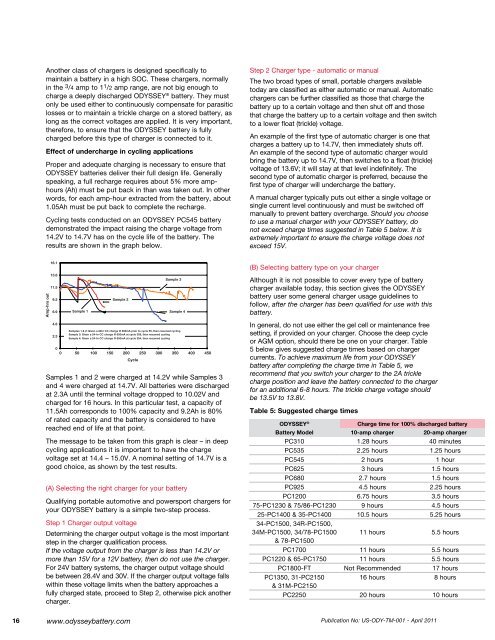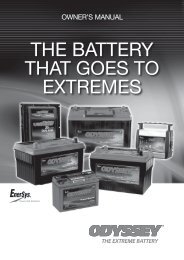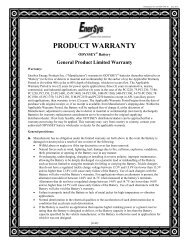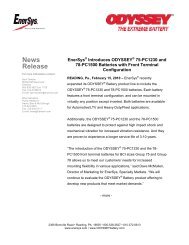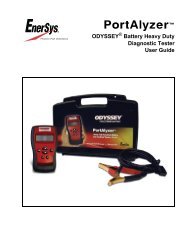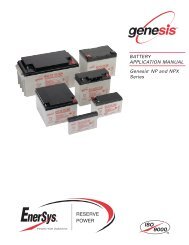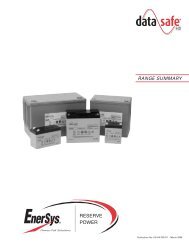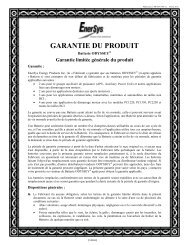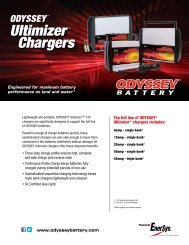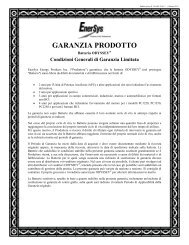Technical Manual - ODYSSEY Batteries
Technical Manual - ODYSSEY Batteries
Technical Manual - ODYSSEY Batteries
You also want an ePaper? Increase the reach of your titles
YUMPU automatically turns print PDFs into web optimized ePapers that Google loves.
Another class of chargers is designed specifically to<br />
maintain a battery in a high SOC. These chargers, normally<br />
in the 3/4 amp to 11/2 amp range, are not big enough to<br />
charge a deeply discharged <strong>ODYSSEY</strong> ® battery. They must<br />
only be used either to continuously compensate for parasitic<br />
losses or to maintain a trickle charge on a stored battery, as<br />
long as the correct voltages are applied. It is very important,<br />
therefore, to ensure that the <strong>ODYSSEY</strong> battery is fully<br />
charged before this type of charger is connected to it.<br />
Effect of undercharge in cycling applications<br />
Proper and adequate charging is necessary to ensure that<br />
<strong>ODYSSEY</strong> batteries deliver their full design life. Generally<br />
speaking, a full recharge requires about 5% more amphours<br />
(Ah) must be put back in than was taken out. In other<br />
words, for each amp-hour extracted from the battery, about<br />
1.05Ah must be put back to complete the recharge.<br />
Cycling tests conducted on an <strong>ODYSSEY</strong> PC545 battery<br />
demonstrated the impact raising the charge voltage from<br />
14.2V to 14.7V has on the cycle life of the battery. The<br />
results are shown in the graph below.<br />
Amp-hrs out<br />
16.1<br />
13.8<br />
11.5<br />
9.2<br />
6.9<br />
4.6<br />
2.3<br />
Sample 1<br />
Sample 2<br />
Samples 1 & 2: Given a 24hr CC charge @ 650mA prior to cycle 55, then resumed cycling<br />
Sample 3: Given a 24-hr CC charge @ 650mA at cycle 359, then resumed cycling<br />
Sample 4: Given a 24-hr CC charge @ 650mA at cycle 254, then resumed cycling<br />
0<br />
0 50 100 150 200 250 300 350 400 450<br />
Cycle<br />
Sample 3<br />
Sample 4<br />
Samples 1 and 2 were charged at 14.2V while Samples 3<br />
and 4 were charged at 14.7V. All batteries were discharged<br />
at 2.3A until the terminal voltage dropped to 10.02V and<br />
charged for 16 hours. In this particular test, a capacity of<br />
11.5Ah corresponds to 100% capacity and 9.2Ah is 80%<br />
of rated capacity and the battery is considered to have<br />
reached end of life at that point.<br />
The message to be taken from this graph is clear – in deep<br />
cycling applications it is important to have the charge<br />
voltage set at 14.4 – 15.0V. A nominal setting of 14.7V is a<br />
good choice, as shown by the test results.<br />
(A) Selecting the right charger for your battery<br />
Qualifying portable automotive and powersport chargers for<br />
your <strong>ODYSSEY</strong> battery is a simple two-step process.<br />
Step 1 Charger output voltage<br />
Determining the charger output voltage is the most important<br />
step in the charger qualification process.<br />
If the voltage output from the charger is less than 14.2V or<br />
more than 15V for a 12V battery, then do not use the charger.<br />
For 24V battery systems, the charger output voltage should<br />
be between 28.4V and 30V. If the charger output voltage falls<br />
within these voltage limits when the battery approaches a<br />
fully charged state, proceed to Step 2, otherwise pick another<br />
charger.<br />
Step 2 Charger type - automatic or manual<br />
The two broad types of small, portable chargers available<br />
today are classified as either automatic or manual. Automatic<br />
chargers can be further classified as those that charge the<br />
battery up to a certain voltage and then shut off and those<br />
that charge the battery up to a certain voltage and then switch<br />
to a lower float (trickle) voltage.<br />
An example of the first type of automatic charger is one that<br />
charges a battery up to 14.7V, then immediately shuts off.<br />
An example of the second type of automatic charger would<br />
bring the battery up to 14.7V, then switches to a float (trickle)<br />
voltage of 13.6V; it will stay at that level indefinitely. The<br />
second type of automatic charger is preferred, because the<br />
first type of charger will undercharge the battery.<br />
A manual charger typically puts out either a single voltage or<br />
single current level continuously and must be switched off<br />
manually to prevent battery overcharge. Should you choose<br />
to use a manual charger with your <strong>ODYSSEY</strong> battery, do<br />
not exceed charge times suggested in Table 5 below. It is<br />
extremely important to ensure the charge voltage does not<br />
exceed 15V.<br />
(B) Selecting battery type on your charger<br />
Although it is not possible to cover every type of battery<br />
charger available today, this section gives the <strong>ODYSSEY</strong><br />
battery user some general charger usage guidelines to<br />
follow, after the charger has been qualified for use with this<br />
battery.<br />
In general, do not use either the gel cell or maintenance free<br />
setting, if provided on your charger. Choose the deep cycle<br />
or AGM option, should there be one on your charger. Table<br />
5 below gives suggested charge times based on charger<br />
currents. To achieve maximum life from your <strong>ODYSSEY</strong><br />
battery after completing the charge time in Table 5, we<br />
recommend that you switch your charger to the 2A trickle<br />
charge position and leave the battery connected to the charger<br />
for an additional 6-8 hours. The trickle charge voltage should<br />
be 13.5V to 13.8V.<br />
Table 5: Suggested charge times<br />
ODySSEy ® Charge time for 100% discharged battery<br />
Battery Model 10-amp charger 20-amp charger<br />
PC310 1.28 hours 40 minutes<br />
PC535 2.25 hours 1.25 hours<br />
PC545 2 hours 1 hour<br />
PC625 3 hours 1.5 hours<br />
PC680 2.7 hours 1.5 hours<br />
PC925 4.5 hours 2.25 hours<br />
PC1200 6.75 hours 3.5 hours<br />
75-PC1230 & 75/86-PC1230 9 hours 4.5 hours<br />
25-PC1400 & 35-PC1400<br />
34-PC1500, 34R-PC1500,<br />
10.5 hours 5.25 hours<br />
34M-PC1500, 34/78-PC1500<br />
& 78-PC1500<br />
11 hours 5.5 hours<br />
PC1700 11 hours 5.5 hours<br />
PC1220 & 65-PC1750 11 hours 5.5 hours<br />
PC1800-FT Not Recommended 17 hours<br />
PC1350, 31-PC2150<br />
& 31M-PC2150<br />
16 hours 8 hours<br />
PC2250 20 hours 10 hours<br />
16 www.odysseybattery.com<br />
Publication No: US-ODY-TM-001 - April 2011


